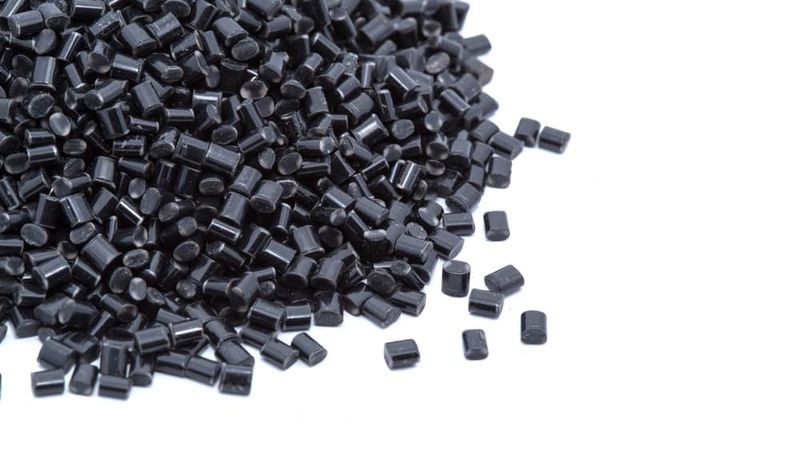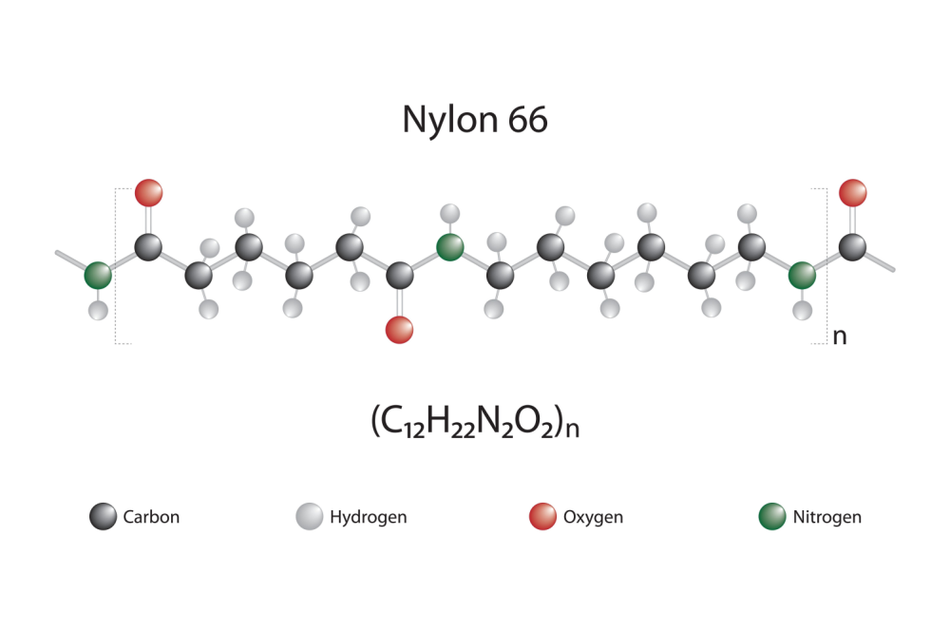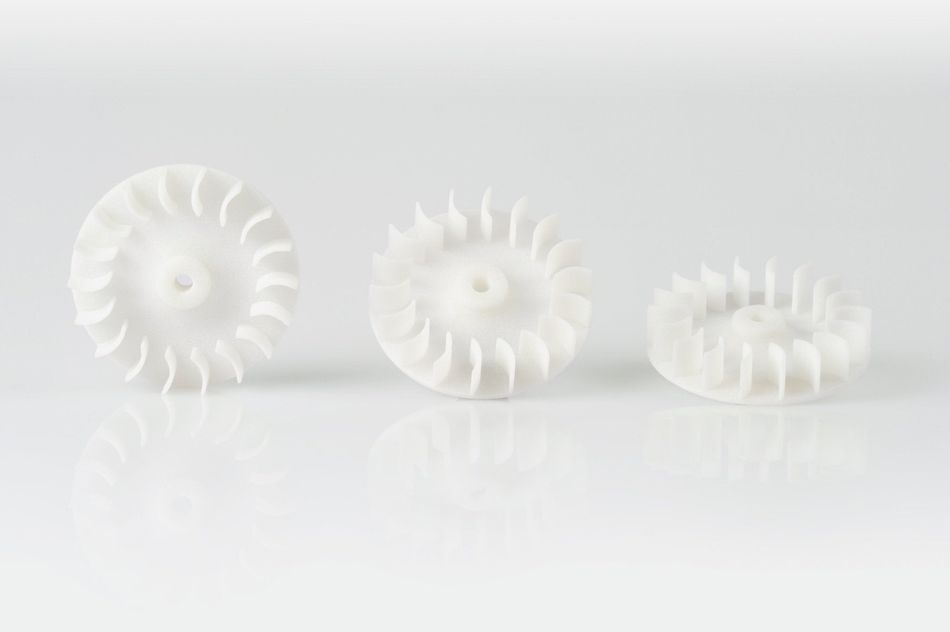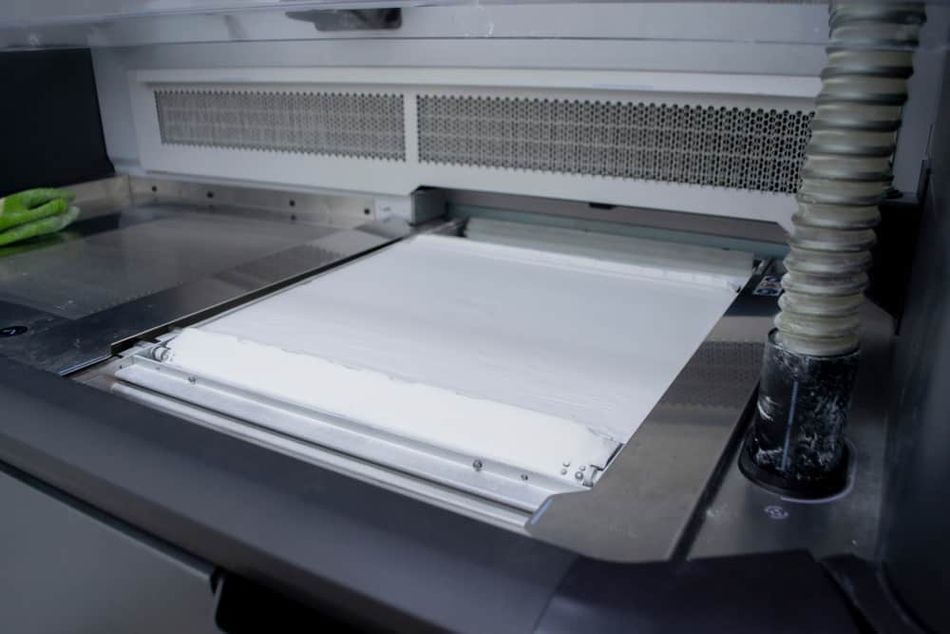Glass-Filled Nylon: The Properties and Benefits
Here's what you need to know about nylon (glass-filled), from material properties, to manufacturing processes, to applications, and more.

Glass-filled nylon is a composite material made up of short glass fibers suspended within a nylon matrix
You’ve probably heard of nylon: the synthetic material was developed in the 1930s by DuPont and quickly revolutionized the world of textiles and materials. It even played a role in securing a win for the Allies in the Second World War. [1]
Since then, the material has only grown in terms of its adoption and applications. It has also been improved upon. Composite nylon blends, such nylon (glass-filled), are creating new opportunities for nylon-based plastics, particularly for engineering applications. This is thanks to the composite material's improved strength and rigidity, as well as other factors.
But how do you actually get 3D printing—or molding or machining, for that matter—with nylon (glass-filled)? And is it worth it for your particular field? Let’s take a look at glass-filled nylon’s unique properties, its benefits and limitations, and much more.
What is Glass-Filled Nylon?

Glass-filled nylon is a composite material made up of short glass fibers suspended within a nylon matrix. These glass fibers function to reinforce the polymer, increasing its strength and resistance compared to the neat (i.e. unfilled) material. Glass-filled nylon is suitable for injection molding, CNC machining, and has more recently become a popular 3D printing material. Due to its strength and good temperature resistance, the polymer is primarily used for engineering applications.
Nylon
Before we dive into the specific properties of the composite material, it’s important to first understand its base material, nylon. Nylon is the name for a group of synthetic polyamide plastics typically derived from non-renewable petroleum (though there are efforts to make the material more ecological). [2]
Nylons are semi-crystalline polymers, which can be tuned to have many different properties and forms: as a fiber it has been used extensively in the production of textiles and garments (famously including nylon stockings); as a film it has been adopted by the food packaging industry [3]; it can also be made into resin, pelletized or powdered for various other manufacturing processes. Generally speaking, nylon is known for its toughness as well as good temperature and chemical resistance.
Glass
The addition of glass enhances nylon’s existing properties and extends the possible applications for the thermoplastic. There are a few different ways of embedding glass into the nylon matrix. With nylon resin, powdered glass particles are mixed into the material; with nylon powder, small spherical glass beads are integrated; and with pellets or filaments, short glass fibers are mixed into the nylon in the extrusion process. It is also possible to control the amount of glass mixed into the nylon base. For instance, 30% glass-filled nylon 66 is a popular blend for extruded nylon.
Recommended reading: Tips and applications for printing with nylon filament
Material Properties of Glass-Filled Nylon

Glass-filled nylons are known for a number of advantageous mechanical, thermal, and chemical properties. Compared to unfilled nylon, these composite blends offer many superior properties, including:
Higher tensile strength
Greater rigidity
Better toughness
Enhanced creep resistance
Higher fatigue resistance
Superior dimensional stability
Excellent chemical resistance
Good wear resistance
Low coefficient of thermal expansion (i.e. temperature resistance)
Another notable characteristic of glass-filled nylon is that it is an insulator, which opens up applications in the electronics field for housings and other components that require non-conductivity. Nylon is also hygroscopic, meaning that it absorbs water from the environment.
Because there are many types of glass-filled nylon, the specific mechanical properties vary, so you should consult material data sheets to find out the exact properties of different brands of glass-filled nylon.
The Benefits and Limitations of Glass-Filled Nylon
Like any material, glass-filled nylon has its pros and cons. Here are the key benefits and limitations of the material that can help to inform whether it’s the right choice for your particular application.
Benefits of Glass-Filled Nylon
Compared to traditional nylon, glass-filled nylons have a significantly higher tensile strength (as much as 70% higher). Glass-filled nylon components can therefore handle greater loads and stresses. [4]
Glass reinforcement in nylon dramatically increases the material’s stiffness. Some Nylon GF blends have up to 80% greater stiffness.
Adding glass fibers to nylon reduces the coefficient of thermal expansion, meaning that the material is more resistant to warping and deformation when exposed to temperature changes.
Glass-filled nylon offers greater resistance to creep, which means it is more resistant to deformation under long-term stresses and temperature increases.
Limitations of Glass-Filled Nylon
The addition of glass fibers or glass particles into nylon does make the resulting composite more brittle than standard nylon. So while glass-filled nylon is resistant to deformation, there is a risk of fracturing under too-high stress.
Embedding glass fibers into nylon makes the material more abrasive. This can cause tools or print heads to wear down at a faster rate than with conventional nylon. Glass-filled nylon parts are therefore also more abrasive, which can wear down adjoining or mated components.
While providing greater strength, glass additives in nylon do make the material heavier. Nylon GF composites can weigh as much as 15% more than unfilled nylon. If lightweighting is a key priority, this can be a disadvantage.
Cost is a final consideration. Due to the additives and additional processing required to make glass-filled nylon, the material is more expensive than its unfilled counterpart.
Glass-filled nylon absorbs moisture and can therefore succumb to structural or dimensional weaknesses if used in humid or wet environments.
How to Make Glass-Filled Nylon Parts

Glass-filled nylon is a versatile material that is sold in many different formats to accommodate different production methods. The most common ways to manufacture glass-filled nylon parts are injection molding, machining, and 3D printing.
Injection Molding
Plastic injection molding is a widely used method for mass producing plastic products. The process consists of injecting a melted thermoplastic, such as nylon, into a mold cavity under pressure and then rapidly cooling the plastic. The hardened part can then be removed and undergo post-processing if needed. There are many grades of reinforced nylon available for injection molding, the most common of which is glass-filled nylon 66, with a fiber reinforcement ratio of between 10 and 50%.
Molded glass-filled nylon is commonly used in applications requiring high wear resistance, such as automotive components, gears, and structural housings. Additionally, its thermal stability and chemical resistance make it ideal for demanding industrial environments. However, special considerations, such as increased mold wear and higher injection pressures, must be taken into account when molding glass-filled nylon.
Machining
In the machining process, different types of tools (such as mills, drills, or lathes) are used to remove material from a blank to create precision parts with extremely high tolerances. While it is possible to machine glass-filled nylon, the material does present some challenges. The fibers embedded in the nylon matrix increase abrasion, which can wear down machining tools quickly. For the best results machining glass-filled nylon and other glass-filled polymers, ceramic or carbide tools are preferred over more traditional steel tools. Slower cutting speeds can also improve outcomes. [5]
3D Printing
There are different 3D printing technologies that can be used to produce glass-filled nylon products, including selective laser sintering (SLS), Multi Jet Fusion (MJF), and fused deposition modeling (FDM) or fused filament fabrication (FFF).
In the SLS process, layers of powdered material are selectively melted and fused using a laser. With each new layer, the part grows in the print bed. PA 12 is the most common nylon grade for SLS and can be reinforced with up to 40% glass fibers. Nylon 3200 Glass-filled is another engineering thermoplastic for SLS. [6] Leading material suppliers such as Evonik, BASF, and EOS offer specialized glass-filled nylon powders for SLS printing, each formulated for high-performance applications in demanding industries.
There are also glass-filled nylon filaments for FDM 3D printing, the most common of which is nylon 6 (PA 6) with 30% filler. Hardened steel nozzles are recommended when printing nylon GF filaments due to their superior abrasion resistance. Some manufacturers of glass-filled nylon filaments include BASF (Ultrafuse PA6 GF30), Polymaker (PolyMide PA6-GF), and Stratasys (Nylon 12CF), each offering variations optimized for different industrial needs.
Recommended reading: Selecting the Right Material for 3D Printing
Applications of Glass-Filled Nylon

There are countless applications for glass-filled nylon. The material’s many advantageous properties—including high strength, durability, electrical insulation, and excellent thermal resistance—meet the requirements of many industries, from automotive, to electronics, to consumer goods.
Automotive Parts
Glass-filled nylon has experienced increased adoption in the automotive sector, which can benefit from the material’s good strength-to-weight ratio.[7] In the automotive industry, weight reduction is a key goal to improve vehicle fuel efficiency: by replacing heavy metal components with the nylon composite, this can be achieved while also reducing costs. Current applications for the material include engine covers, speedometer gears, brake fluid and windshield wiper parts, wire housings and connectors, and more.
Electronics
Glass-filled nylon plays a critical role in electronics and hardware design due to its combination of strength, heat resistance, and electrical insulation. It is commonly used in electronic enclosures, such as industrial control boxes and consumer gadget casings. For example, 30% glass-filled nylon is used for router chassis and instrument cases, offering stiffness to prevent flexing or cracking. Additionally, its heat resistance enables it to withstand both internal and external temperatures, and its electrical insulating properties eliminate the need for additional linings. UV-stabilized versions are also used for outdoor enclosures, like heavy-duty cable gland locknuts, where they resist environmental stress and provide long-term durability.
Connectors and Sockets
In electrical applications, glass-filled nylon is frequently used for connectors, plugs, and sockets due to its mechanical strength and heat resistance. Electrical connectors, including PCB connectors, automotive connectors, and MIL-spec components, often use glass-reinforced nylon to provide structural integrity and enhance heat resistance during high-current operation. For instance, automotive connector shells made from nylon 6/6 GF30 can endure the high temperatures of engine bays without deforming.
Mounting Hardware and Structural Components
Glass-filled nylon is ideal for small structural parts in electronic systems, such as standoffs, spacers, and brackets. In electric vehicles, for example, glass-filled nylon standoffs are used to secure battery cells and circuit boards, offering strength to handle vibrations while also providing thermal insulation. Similarly, industrial machine components like mounting feet and pull handles are made from glass-filled nylon for their robustness and reliability. These parts withstand heavy loads and ensure that components remain electrically isolated while maintaining thermal stability.
Cable Ties, Clips, and Clamps
Glass-filled nylon is often used for cable ties, clips, and clamps in demanding environments such as aerospace or high-temperature areas. While standard nylon ties offer flexibility, glass-filled nylon is used in mounting bases or clips where extra strength is needed. For example, fiber optic cable management components, like a 25% GF nylon fiber bend bracket, ensure that cables remain intact without bending or breaking, providing reliable support in data centers and similar environments.
Switchgear and Electrical Insulators
Glass-filled nylon is commonly used in electrical equipment components like switchgear, coil formers, and insulating spacers. Transformer coil bobbins made from 30% glass-filled nylon 6/6 provide structural support and electrical insulation while withstanding high temperatures. These bobbins help maintain the integrity of copper windings, ensuring they remain stable in various conditions. Glass-filled nylon’s low thermal expansion, high heat distortion point, and resistance to moisture absorption make it a preferred material for these applications.
Glass Fiber Versus Carbon Fibers
Glass-filled nylon and carbon fiber-filled nylon are both reinforced composites, but they differ in their reinforcement material and resulting properties. Glass-filled nylon offers excellent dimensional stability, good wear resistance, and a high strength-to-weight ratio, making it ideal for automotive, aerospace, and industrial applications. However, it can be more brittle than unfilled nylon.
Carbon fiber-filled nylon, on the other hand, uses carbon fibers, which provide superior stiffness, higher strength, and reduced thermal expansion compared to glass fibers. This makes carbon fiber-filled nylon particularly suited for applications that require exceptional rigidity and dimensional precision, such as in robotics, high-performance automotive parts, and precision equipment. Carbon fiber also offers better fatigue resistance, but the material can be more expensive than glass-filled nylon.
Glass-Filled Nylon Alternatives
Alternatives to glass-filled nylon include the aforementioned carbon fiber-filled nylon, which offers superior stiffness, strength, and lower weight, making it ideal for high-performance applications.
Another option is fiberglass-reinforced polypropylene (PP), which provides excellent chemical resistance and lower weight but with slightly less strength than glass-filled nylon. Additionally, polyphenylene sulfide (PPS) and polyetheretherketone (PEEK) are high-performance materials with greater thermal stability and chemical resistance, suitable for extreme conditions.
For applications requiring electrical insulation and low moisture absorption, both liquid crystal polymers (LCPs) and epoxy resins can also serve as suitable alternatives, offering high strength and thermal resistance.
Conclusion
Glass-filled nylon is a high-performance composite that combines the strength of glass fibers with the versatility of thermoplastic nylon. This reinforcement enhances tensile strength, rigidity, chemical resistance, and thermal stability, making it ideal for demanding applications.
Compared to unfilled nylon, glass-filled variants offer superior dimensional stability and toughness, allowing them to perform reliably under stress and high temperatures. However, the material’s abrasiveness poses challenges in machining and 3D printing, requiring hardened tools and wear-resistant nozzles to maintain precision and longevity.
With its excellent strength-to-weight ratio, glass-filled nylon is increasingly used as a metal replacement in automotive and industrial applications. Its insulating properties also make it valuable for electrical components like wire connectors and housings. Combining strength, durability, and insulation, glass-filled nylon remains a versatile choice for modern engineering needs.
Frequently Asked Questions
What does “glass-filled nylon” mean?
Glass-filled nylon is a composite plastic reinforced with chopped glass fibers to improve strength, stiffness, and thermal stability. The percentage of glass filler, such as 30% GF (glass fiber), determines its mechanical properties. This modification makes it a durable alternative to standard nylon in demanding applications.
How much stronger is glass-filled nylon compared to regular nylon?
Glass-filled nylon is stronger than unfilled nylon, with tensile strength increasing by 50–70% at 30% GF content. For example, nylon 6/6 with 30% glass fill can reach 130–150 MPa, compared to ~75 MPa for unfilled nylon. However, it becomes less flexible and more brittle as glass content rises.
What are typical glass fiber percentages in glass-filled nylon?
Depending on the manufacturing method, glass-filled nylon typically contains 10–50% glass fiber, with 20–30% being the most common for balancing strength and processability. Lower percentages (10–15%) offer moderate reinforcement, while higher levels (40%+) maximize strength but increase brittleness and molding difficulty. Applications range from consumer goods (15%) to automotive parts (30%) and structural components (40%).
Can glass-filled nylon withstand high temperatures?
Yes, glass-filled nylon has a higher heat resistance than unfilled nylon, with a heat deflection temperature (HDT) often exceeding 130°C for 30% GF nylon. Continuous-use temperatures are typically around 120°C, making it suitable for automotive and industrial applications. Specialized grades can withstand even higher temperatures.
Is glass-filled nylon electrically insulating?
Yes, glass-filled nylon remains an excellent electrical insulator, making it ideal for connectors, switch housings, and electronic enclosures. While it maintains high resistivity, moisture absorption can slightly reduce surface insulation. Despite this, it is widely used in electrical applications requiring durability and heat resistance.
References
[1] “Nylon: A Revolution in Textiles”. Science History Institute, October 2008. [Accessed February 2023] https://www.sciencehistory.org/distillations/nylon-a-revolution-in-textiles
[2] Hu R, Li M, Shen T, Wang X, Sun Z, Bao X, Chen K, Guo K, Ji L, Ying H, Ouyang P. A sustainable process to 100% bio-based nylons integrated chemical and biological conversion of lignocellulose. Green Energy & Environment. 2022 Nov 25. https://doi.org/10.1016/j.gee.2022.11.004
[3] “Nylon Films”. Polymer Properties Database. [Accessed February 2023] https://polymerdatabase.com/Films/Nylon%20Films.html
[4] “Considerations for Using Glass-Filled Nylon in Small Plastic Parts Manufacturing”. AIM Processing, July 2017. [Accessed February 2023] https://www.aimprocessing.com/blog/considerations-for-using-glass-filled-nylon-in-small-plastic-parts-manufacturing
[5] “What Makes Glass-Filled Plastic Machining So Difficult”. Reading Plastic & Metal. [Accessed February 2023] https://readingplastic.com/glass-filled-plastic-machining/
[6] “Nylon 3200 Glass-filled 3D printing material”. Sculpteo. [Accessed February 2023] https://www.sculpteo.com/en/materials/sls-material/glass-filled-nylon-material/
[7] “Increasing Use of Glass-Filled Nylon in Automotive Industry Likely to Transform the Overall Market”. Eminent Research & Advisory Services, March 2022. [Accessed February 2023] https://www.einnews.com/pr_news/573937890/increasing-use-of-glass-filled-nylon-in-automotive-industry-likely-to-transform-the-overall-market-evaluates-fact-mr
Table of Contents
What is Glass-Filled Nylon?Nylon GlassMaterial Properties of Glass-Filled NylonThe Benefits and Limitations of Glass-Filled NylonBenefits of Glass-Filled NylonLimitations of Glass-Filled NylonHow to Make Glass-Filled Nylon PartsInjection MoldingMachining3D PrintingApplications of Glass-Filled NylonAutomotive PartsElectronicsConnectors and SocketsMounting Hardware and Structural ComponentsCable Ties, Clips, and ClampsSwitchgear and Electrical InsulatorsGlass Fiber Versus Carbon FibersGlass-Filled Nylon AlternativesConclusionFrequently Asked QuestionsReferences